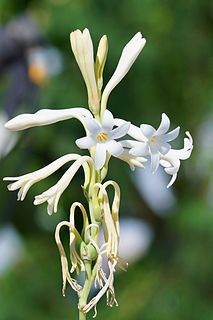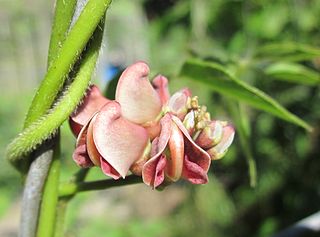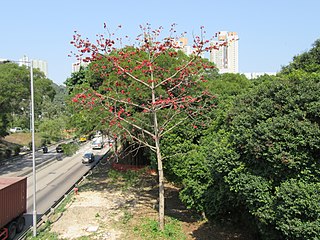
The Fabaceae or Leguminosae, commonly known as the legume, pea, or bean family, are a large and agriculturally important family of flowering plants. It includes trees, shrubs, and perennial or annual herbaceous plants, which are easily recognized by their fruit (legume) and their compound, stipulate leaves. The family is widely distributed, and is the third-largest land plant family in number of species, behind only the Orchidaceae and Asteraceae, with about 765 genera and nearly 20,000 known species.

Forsythia, is a genus of flowering plants in the olive family Oleaceae. There are about 11 species, mostly native to eastern Asia, but one native to southeastern Europe. Forsythia – also one of the plant's common names – is named after William Forsyth.

Root vegetables are underground plant parts eaten by humans as food. Although botany distinguishes true roots from non-roots, the term "root vegetable" is applied to all these types in agricultural and culinary usage.

Calypso is a genus of orchids containing one species, Calypso bulbosa, known as the calypso orchid, fairy slipper or Venus's slipper. It is a perennial member of the orchid family found in undisturbed northern and montane forests. It has a small pink, purple, pinkish-purple, or red flower accented with a white lip, darker purple spottings, and yellow beard. The genus Calypso takes its name from the Greek signifying concealment, as they tend to favor sheltered areas on conifer forest floors. The specific epithet, bulbosa, refers to the bulb-like corms.

Agave amica, formerly Polianthes tuberosa, the tuberose, is a perennial plant in the family Asparagaceae, subfamily Agavoideae, extracts of which are used as a note in perfumery. Now widely grown as an ornamental plant, the species was originally native to Mexico.

Apios priceana is a rare species of flowering plant in the legume family known by the common names Price's potato-bean, Price's groundnut, and traveler's delight. It is a climbing yellow-green vine in the growing from a stout, potato-like tuber. It is native to the U.S. states of Alabama, Mississippi, Kentucky, and Tennessee. It occurred in Illinois in the past but its population there was destroyed. There are about 25 known occurrences. It is federally listed as a threatened species.

Apios americana, sometimes called the American groundnut, potato bean, hopniss, Indian potato, hodoimo, America-hodoimo, cinnamon vine, or groundnut is a perennial vine that bears edible beans and large edible tubers. Its vine can grow to 1–6 m (3.3–19.7 ft) long, with pinnate leaves 8–15 cm (3.1–5.9 in) long with 5–7 leaflets. The flowers are usually pink, purple, or red-brown, and are produced in dense racemes 7.5–13 cm (3.0–5.1 in) in length. The fruit is a legume (pod) 5–13 cm (2.0–5.1 in) long. Botanically speaking, the tubers are rhizomatous stems, not roots. Its natural range is from Southern Canada down through Florida and West as far as the border of Colorado. It is a larval host for the Epargyreus clarus.

Psoralea esculenta, common name prairie turnip or timpsula, is an herbaceous perennial plant native to prairies and dry woodlands of central North America, which bears a starchy tuberous root edible as a root vegetable. The plant is also known as Pediomelum esculentum. English names for the plant include tipsin, teepsenee, breadroot, breadroot scurf pea, large Indian breadroot and pomme blanche. The prairie turnip was a staple food of the Plains Indians.

Sagittaria latifolia is a plant found in shallow wetlands and is sometimes known as broadleaf arrowhead, duck-potato, Indian potato, Katniss, or wapato. This plant produces edible tubers that have traditionally been extensively used by the Native Americans in the lower Columbia River basin, as well as the Omaha and Cherokee nations.

Keteleeria fortunei is a coniferous evergreen tree native to Hong Kong and China in the provinces of Fujian, Guangdong, Guangxi, Guizhou, Hunan, Jiangxi, Yunnan, and Zhejiang. The tree grows in hills, mountains, and broadleaf forests at elevations of 200–1400 m. The species is named after Scottish botanist Robert Fortune, who discovered the tree in 1844.

Bombax ceiba, like other trees of the genus Bombax, is commonly known as cotton tree. More specifically, it is sometimes known as Malabar silk-cotton tree; red silk-cotton; red cotton tree; or ambiguously as silk-cotton or kapok, both of which may also refer to Ceiba pentandra.

Apios is a genus of flowering plants in the family Fabaceae. It belongs to the subfamily Faboideae. Its member species are found in North America and Asia between latitudes of 50° and 20°. The term "Apios" comes from the Greek word for "pear" and may refer the pear shape of some tubers. Several members of this genus are known to have edible, tuberous roots.

Leporella fimbriata, commonly known as hare orchid or fringed hare orchid, is the only species in the flowering plant genus Leporella in the orchid family, Orchidaceae and is endemic to the southern Australia mainland. It is related to orchids in the genus Caladenia but has an unusual labellum and does not have hairy leaves. Its pollination mechanism is also unusual.

Lyperanthus, commonly known as beak orchids, is a genus of flowering plants from the orchid family, Orchidaceae, that is endemic to Australia. There are two species, one in Western Australia and the other in four eastern Australian states, distinguished by their single long, narrow, leathery leaf and dull coloured flowers which have prominent short calli on their labellum. Both form loose colonies which reproduce asexually from their tubers, and sexually using their flowers.

Apios carnea is a vine in the Fabaceae family found in Asia in a narrow band from the Himalayas of Nepal across Bhutan, India, Bangladesh, Myanmar, China, Laos, and Vietnam. Petioles are 5–8 cm long; compound leave typically have 5 leaflets. The flowers are found in long peduncled flexuous secund racemes 15–23 cm long. The reddish, flesh-colored flowers are showy and have potential as an ornamental. Pods are 10–13 cm long and contain 12 to 16 seeds.
Epiblema grandiflorum, commonly known as babe-in-a-cradle, is the only species in the flowering plant genus Epiblema in the orchid family, Orchidaceae and is endemic to the south-west of Western Australia. It is a colony-forming orchid which grows in peaty swamps near the coast. Its flowers are purple with ribbon-like strands attached to its labellum and a broad, petal-like column.

Iris speculatrix is a beardless iris in the genus Iris, in the subgenus Limniris and in the series Chinenses of the genus. It is a rhizomatous herbaceous perennial, from Asia, found in China, Hong Kong and Taiwan. It has dark green, evergreen leaves, long slender stem and flowers in various blue shades, from violet, lilac, lavender, to light blue.
Iris mandshurica is a species in the genus Iris, it is also in the subgenus of Iris and in the Psammiris section. It is a rhizomatous perennial, it is found in Russia, China, and Korea. It has green sword-like leaves, smooth green stem and yellow flowers, with yellow-purple veining and a yellow beard. It is cultivated as an ornamental plant in temperate regions.
Iris goniocarpa is a plant species in the genus Iris, it is also in the subgenus of Iris and in the section Pseudoregelia. It is a rhizomatous perennial, from China, India, Burma and Bhutan. It has yellow green to dark green, long leaves, slender stem and, one flower between blue, lavender-blue, lilac, blue-violet or blue-purple. It is cultivated as an ornamental plant in temperate regions.
Iris leptophylla is a plant species in the genus Iris, it is also in the subgenus Iris and in the section Pseudoregelia. It is a rhizomatous perennial, from China. It has thin, long grey-green leaves, long slender stem and 2 fragrant purple, blue-purple, violet or lavender pink flowers. It is cultivated as an ornamental plant in temperate regions.
















